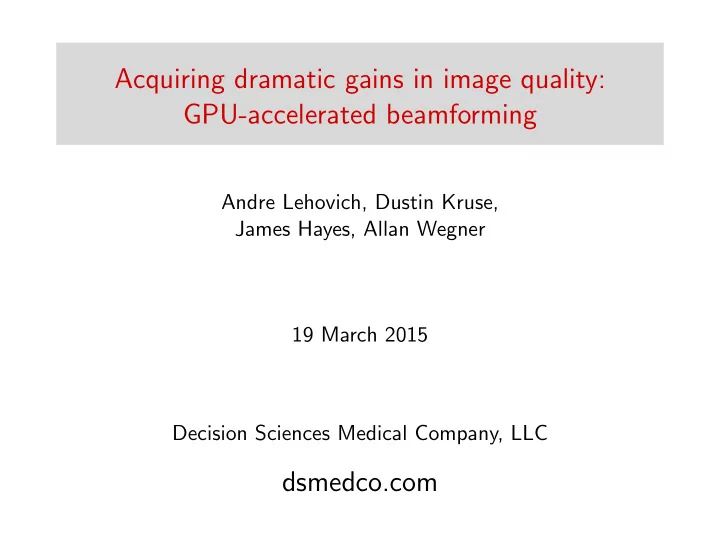

Acquiring dramatic gains in image quality: GPU-accelerated beamforming Andre Lehovich, Dustin Kruse, James Hayes, Allan Wegner 19 March 2015 Decision Sciences Medical Company, LLC dsmedco.com
Talk overview An apology about the title: in this talk I will not be presenting: ◮ Breathtaking images. ◮ Scientific proof that synthetic aperture improves image quality. (Although we’re working hard on both fronts!) Rather, I will be talking about: ◮ The differences between image formation in conventional B-mode ultrasound and synthetic aperture. ◮ The improvements synthetic aperture offers over B-mode. ◮ Why this old idea is finally about to catch on.
Classical B-mode Each line of image is echo intensity at a certain distance from face of the transducer element. A simplified view of the imaging process: 1. Transmit on element x . 2. Wait specified delay. 3. Receive on element x . 4. Assign received value to the appropriate pixel. Pixel is determined by delay time and speed of sound.
Resolution of B-mode The lateral resolution is determined by the transducer aperture, bandwidth, and center frequency. In general a wider aperture has finer resolution. 1 MHz typical lateral B-mode resolution is 3mm. 15 MHz typical lateral B-mode resolution is 0.3mm.
Frame-rate and time-complexity of B-mode The speed of sound in tissue means each line of the image takes 0.1ms to measure, if imaging to a depth of 15cm. 2D image with 512 lines takes 50ms to measure, resulting in a maximum frame rate of 20 fps. (A 3-D imaging system has more lines to measure, thus lower fps.) B-mode ultrasound has low computational complexity: O ( n pixels ). First commercial system went on market in mid 1960s. Today images are typically formed using FPGAs or ASICs.
The limiting factors in B-mode ultrasound The speed of sound limits the B-mode frame rate. The physics of the transducer limits resolution. Computation is not a problem: existing and affordable hardware keeps up with the data rate.
Synthetic aperture Delay and sum reconstruction: 1. Transmit on element x . 2. Wait specified delay. 3. Receive on all elements. 4. Add received value to the appropriate set of pixels. Set is determined by delay time and speed of sound. Assuming constant speed of sound, set is an ellipse.
A question to see if you’re awake In the setup on the previous slide we create the image by transmitting on 1 element and receiving on all elements. The measurement process takes 0.1ms, so the theoretical upper bound on frame rate is 10,000 fps! How would the image quality of the individual frames compare with those of conventional B-mode (20 fps)?
Answer The image quality would be lower! Because using only a single transmit element means much less energy is used to form the image. Exteremely high frame rate can be achieved at sacrifice of SNR and resolution. But if one transmits on many elements in succession, one still gets a faster frame rate than B-mode, but also retains high SNR and good resolution.
Time complexity of synthetic aperture image forming Time complexity is no better than O ( n pixels n Tx n Rx ). Speed of sound correction makes it worse. And n pixels is larger than B-mode, because the larger synthetic aperture allows for better resolution. And n elements is larger than B-mode, because more elements gives an even larger synthetic aperture and thus better resolution (and larger FOV).
The limiting factor in synthetic-aperture ultrasound Ultrasound is an interactive modality, so processing must be realtime. Ultrasound hardware traditionally costs one or two orders of magnitude less than CT or MRI, once installation costs are included. Ability to cheaply process the data in realtime is the limiting factor for both resolution and frame rate...
What’s required before we’ll see synthetic aperture in the clinic? To make synthetic aperture clinically feasible we need very fast and cheap computers. E.g. GPU. But to use synthetic aperture in an R&D setting we also need something else: the ability to program in a high-level language, e.g. Matlab, Python. As scientists and engineers developing new imaging systems we need to have confidence that our algorithms are correct before we make them run fast.
Framerates we’ve achieved so far Input data comes from a simulation pipeline. Image size fps CPU GPU N tx N rx 512x512 1 64 10 E5-1620v2 GTX-760 512x512 6 64 2 E5-1620v2 GTX-760 512x512 1 64 32 E5-2670 K20 512x512 6 64 5 E5-2670 K20 512x512 12 64 2 E5-2670 K20 The GTX-760 was chosen because it is the fastest GPU that will fit inside the chasis of an off-the-shelf ultrasound system. The K20 is about 3-times faster for our workloads. Framerates are lower than other labs quote because we image form in Matlab, instead of directly calling CUDA at a lower level.
Challenges in doing synthetic aperture on the GPU The GPU works best for scientific problems where you can amortize the costs of moving data in/out of the GPU over a large problem (many pixels, lots of data). But we need to do move data in/out many times a second to retain realtime display. Achieving top performance on a GPU still requires low-level programming, which is not conducive to early stages of product development. Current maximum RAM is 12GB per GPU.
Questions? dsmedco.com
Recommend
More recommend